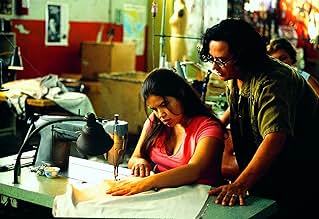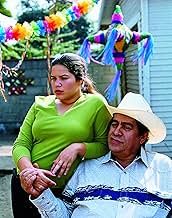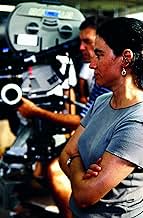IMDb रेटिंग
6.9/10
8.6 हज़ार
आपकी रेटिंग
अपनी भाषा में प्लॉट जोड़ेंIn East Los Angeles, an 18-year-old struggles between her ambitions of going to college and the desires of her domineering mother for her to get married, have children, and oversee the small... सभी पढ़ेंIn East Los Angeles, an 18-year-old struggles between her ambitions of going to college and the desires of her domineering mother for her to get married, have children, and oversee the small, rundown family-owned textile factory.In East Los Angeles, an 18-year-old struggles between her ambitions of going to college and the desires of her domineering mother for her to get married, have children, and oversee the small, rundown family-owned textile factory.
- पुरस्कार
- 8 जीत और कुल 4 नामांकन
Lourdes Perez Nido
- Rosali
- (as Lourdes Perez)
Celina Belizan
- Glitz Receptionist
- (as Celina Belazin)
Jim Ishida
- Landlord
- (as Jimmy Ishida)
Agapito Leal
- Dr. Lopez
- (as Pete Leal)
फ़ीचर्ड समीक्षाएं
I was showed this movie in my 11th grade class and I never thought that a movie like this would really be funny and dramatic. I really didn't think that this movie was going to be any good but I was wrong. I did what a lot of people do now a days, judged a book or movie by it's cover. But the message of this movie is to feel easy going about that very cover. Real Women Have Curve is a film that is about Mexican Americans and also the a view of how society standardize "sexy". Ana being a little overweight finds herself on an quest to find the sexy women in her and change the views of not only herself but the views of others as well.
`Real Women Have Curves' feels a bit like a modern ethnic version of `Georgy Girl,' featuring a free-spirited young woman named Ana who doesn't quite fit the mold of what society believes a woman should look like.
Ana is a somewhat `overweight' high school senior living in East LA who has dreams of being the first person in her family to go to college. Her parents, however, have other plans for her life, which basically involve marriage, motherhood and a job working in her older sister's dress factory. Ana faces the struggle common to many young people who happen to be first-generation Americans: should she conform to the old-fashioned customs and traditions of her family or should she set out to make it on her own with all the advantages and opportunities available to people in this society? `Real Women Have Curves' avoids becoming a culture clash cliché through its keen observation of the minutiae of everyday life. Unlike most films, `Real Women' actually explores the day-to-day struggles of the working class in this country. The people in this film worry about whether or not they will be able to make a go of their businesses, whether or not their bills will get paid, whether or not a promising young student will be allowed to go to college and make something of herself or just end up as a cog in the system that absorbs so many of the underclass. It's these slice-of-life details that make the film interesting.
Ana's main foil is her own mother, who believes not only that her daughter is overweight and, thereby, ruining her chances to make an acceptable marriage, but that she must forego college in order to help with the family business. The majority of the conflict in the film occurs between these two women, both equally hardheaded, moody and determined to get what they want. America Ferrara as Ana, Lupe Ontiveras as her mother and Ingrid Oliu as Estela, her hardworking, levelheaded sister, create characters who are believable, subtle and instantly recognizable. Writers Josefina Lopez and George LaVoo have a sharp ear for the way people actually speak. Director Patricia Cardoso doesn't try to impress us with fancy camera angles or clever cutting. Instead, she lets the story develop naturally, allowing us to eavesdrop on a milieu that may seem strange to some of us. Cardoso knows full well that the universal nature of what she is showing us will draw us into the story and these characters' lives. It's nice, too, to see a film in which the young people are spending their time trying to get into good colleges instead of indulging in all the high school hijinks and hoopla we usually see in more mainstream movies these days.
True, the movie does sacrifice some of its verisimilitude by trying a bit too hard to be a `feel good' experience. One occasionally senses a certain straining for the upbeat moral message, as when Ana convinces her coworkers to strip down to their undies in the factory as a statement about how women should not be ashamed of their bodies just because they aren't a size six. But the film more than makes up for that in the unconventional way in which it treats Ana's departure from her mother at the end.
`Real Women Have Curves' is a small movie but a universal one.
Ana is a somewhat `overweight' high school senior living in East LA who has dreams of being the first person in her family to go to college. Her parents, however, have other plans for her life, which basically involve marriage, motherhood and a job working in her older sister's dress factory. Ana faces the struggle common to many young people who happen to be first-generation Americans: should she conform to the old-fashioned customs and traditions of her family or should she set out to make it on her own with all the advantages and opportunities available to people in this society? `Real Women Have Curves' avoids becoming a culture clash cliché through its keen observation of the minutiae of everyday life. Unlike most films, `Real Women' actually explores the day-to-day struggles of the working class in this country. The people in this film worry about whether or not they will be able to make a go of their businesses, whether or not their bills will get paid, whether or not a promising young student will be allowed to go to college and make something of herself or just end up as a cog in the system that absorbs so many of the underclass. It's these slice-of-life details that make the film interesting.
Ana's main foil is her own mother, who believes not only that her daughter is overweight and, thereby, ruining her chances to make an acceptable marriage, but that she must forego college in order to help with the family business. The majority of the conflict in the film occurs between these two women, both equally hardheaded, moody and determined to get what they want. America Ferrara as Ana, Lupe Ontiveras as her mother and Ingrid Oliu as Estela, her hardworking, levelheaded sister, create characters who are believable, subtle and instantly recognizable. Writers Josefina Lopez and George LaVoo have a sharp ear for the way people actually speak. Director Patricia Cardoso doesn't try to impress us with fancy camera angles or clever cutting. Instead, she lets the story develop naturally, allowing us to eavesdrop on a milieu that may seem strange to some of us. Cardoso knows full well that the universal nature of what she is showing us will draw us into the story and these characters' lives. It's nice, too, to see a film in which the young people are spending their time trying to get into good colleges instead of indulging in all the high school hijinks and hoopla we usually see in more mainstream movies these days.
True, the movie does sacrifice some of its verisimilitude by trying a bit too hard to be a `feel good' experience. One occasionally senses a certain straining for the upbeat moral message, as when Ana convinces her coworkers to strip down to their undies in the factory as a statement about how women should not be ashamed of their bodies just because they aren't a size six. But the film more than makes up for that in the unconventional way in which it treats Ana's departure from her mother at the end.
`Real Women Have Curves' is a small movie but a universal one.
Thanks to a beautifully subtle script, equally subtle direction and brilliant performances from all the leads, Real Women Have Curves comes across as a superbly soulful and insightful slice of life. The always great Lupe Ontiveros is maddeningly tragic as the selfish mother who stubbornly refuses to see beyond her own needs, and America Ferrera blazes across the screen in blissful defiance - the smart girl who instinctively knows she's more than just the sum of her body parts and finds the strength inside herself to back up that belief with or without her mother's blessing. Kudos to everyone connected with this enlightened and enlightening movie.
How could I be so blessed with 2 Mexican treasures within weeks of each other? After the heady romanticism and visual artistry of Julie Taymor's `Frida,' I was hardly prepared to see another arresting, Mexican melodrama, Patricia Cardoso's `Real Women Have Curves.' Every woman who thinks about her weight should see this movie-it will make you a convert to the humane notion that all bodies are beautiful. And it will reveal a deeply humane culture at the same time.
Naturally beautiful and full-bodied actress America Ferrera plays Ana, a Mexican American whose graduation and scholarship to Columbia University threaten the family's unity and the control by her mother, who tells stories of runaway girls with disastrous ends and the admonition, `That's what happens to girls who don't listen to their mothers.'
Like teenagers in any culture, Ana is trying to break away from a domineering culture and mother while she also achieves a balanced acceptance of her zaftig body. The scene where she and the other seamstresses in her sister's sweat shop remove their outer clothes to escape the heat and eventually admire their bulging, stretch-marked bodies is about as loving and lyrical as any other I have seen where Hollywood's obsession with world-class beauty is obliterated by the sheer attractiveness of women celebrating the imperfections of their bodies.
Equally so, when Ana loses her virginity, she tells her lover,
"Turn the lights on. I want you to see me. See, this is what I look like." He responds, "You're not fat. You're beautiful.' It's easy to see why this film won awards at Cannes for audience appreciation and ensemble acting. It is a hymn to a culture that values family and a girl who values herself.
Naturally beautiful and full-bodied actress America Ferrera plays Ana, a Mexican American whose graduation and scholarship to Columbia University threaten the family's unity and the control by her mother, who tells stories of runaway girls with disastrous ends and the admonition, `That's what happens to girls who don't listen to their mothers.'
Like teenagers in any culture, Ana is trying to break away from a domineering culture and mother while she also achieves a balanced acceptance of her zaftig body. The scene where she and the other seamstresses in her sister's sweat shop remove their outer clothes to escape the heat and eventually admire their bulging, stretch-marked bodies is about as loving and lyrical as any other I have seen where Hollywood's obsession with world-class beauty is obliterated by the sheer attractiveness of women celebrating the imperfections of their bodies.
Equally so, when Ana loses her virginity, she tells her lover,
"Turn the lights on. I want you to see me. See, this is what I look like." He responds, "You're not fat. You're beautiful.' It's easy to see why this film won awards at Cannes for audience appreciation and ensemble acting. It is a hymn to a culture that values family and a girl who values herself.
The movie Real Women Have Curves is a 2002 comedy directed by Patricia Cardoso. Ana (America Ferrera) is a young and smart girl from a Mexican immigrant family, who graduates from the famous Beverly High School of California, and gets accepted in Columbia University with a full scholarship. Controlled by her mother Mrs. Carmen (Lupe Ontiveros), who strongly believes that a girl's fate is to learn to work hard and learn to take care of her future husband. Raul Garcia (Jorge Cervera Jr.) Ana's father and Mr. Guzman (George Lopez) Ana's English teacher play wonderful mediators and defend Ana to go to college.
This is a movie for everyone to see. Children can confront parents in laughter, while enjoying this together. It reveals the constant battle between mother and daughter, but most of all; it shows how challenging it is for smart children from uneducated families to pursue a higher education.
Although the comedian George Lopez, from the George Lopez show, is not an actor, he gives a high performance in this movie playing the role of the teacher who tries by all means to see one of his smartest students succeeding in what she deserves, despite the character hostile of Lupe Ontiveros, who sees her daughter going against the value of their traditions.
This movie makes me think of the Cider House Rules, in which Dr. Larch (Michael Caine) always reminds Homer Well (Toby McGuire), his traditions and what he comes to accomplish in life. Like America Ferrera, it is hard for Toby McGuire to break the rules, and leave the orphanage to discover what is out there for him.
Patricia Cardoso increases the suspense in this movie with the motif "red color," which appears every time America Ferrera's future is being discussed. She makes this screenplay so funny and devoid of bad scenes or language. This is what Robert Ebert from the Chicago Tribune calls "enormously entertaining for moviegoers of any age."
This is a movie for everyone to see. Children can confront parents in laughter, while enjoying this together. It reveals the constant battle between mother and daughter, but most of all; it shows how challenging it is for smart children from uneducated families to pursue a higher education.
Although the comedian George Lopez, from the George Lopez show, is not an actor, he gives a high performance in this movie playing the role of the teacher who tries by all means to see one of his smartest students succeeding in what she deserves, despite the character hostile of Lupe Ontiveros, who sees her daughter going against the value of their traditions.
This movie makes me think of the Cider House Rules, in which Dr. Larch (Michael Caine) always reminds Homer Well (Toby McGuire), his traditions and what he comes to accomplish in life. Like America Ferrera, it is hard for Toby McGuire to break the rules, and leave the orphanage to discover what is out there for him.
Patricia Cardoso increases the suspense in this movie with the motif "red color," which appears every time America Ferrera's future is being discussed. She makes this screenplay so funny and devoid of bad scenes or language. This is what Robert Ebert from the Chicago Tribune calls "enormously entertaining for moviegoers of any age."
क्या आपको पता है
- ट्रिवियाThe producers put out a casting call for girls who were "fat" or "overweight", and had thousands of girls show up who were clearly not fat or overweight, but all thought that they were.
- गूफ़Ana's boyfriend, about to graduate from high school, says he will now go to "Teachers College." Teachers College is a graduate school only; it has no undergraduate program.
- कनेक्शनFeatured in HBO First Look: Real Women Have Curves (2002)
- साउंडट्रैकChica Dificil
Written by Héctor Buitrago and Andrea Echeverri
Performed by Aterciopelados
Courtesy of BMG Latin
टॉप पसंद
रेटिंग देने के लिए साइन-इन करें और वैयक्तिकृत सुझावों के लिए वॉचलिस्ट करें
- How long is Real Women Have Curves?Alexa द्वारा संचालित
विवरण
- रिलीज़ की तारीख़
- कंट्री ऑफ़ ओरिजिन
- भाषाएं
- इस रूप में भी जाना जाता है
- Las mujeres verdaderas tienen curvas
- फ़िल्माने की जगहें
- Boyle Heights, लॉस एंजेल्स, कैलिफोर्निया, संयुक्त राज्य अमेरिका(Ana Garcia's house)
- उत्पादन कंपनियां
- IMDbPro पर और कंपनी क्रेडिट देखें
बॉक्स ऑफ़िस
- बजट
- $30,00,000(अनुमानित)
- US और कनाडा में सकल
- $58,53,194
- US और कनाडा में पहले सप्ताह में कुल कमाई
- $1,83,772
- 20 अक्तू॰ 2002
- दुनिया भर में सकल
- $77,77,790
- चलने की अवधि1 घंटा 30 मिनट
- रंग
- ध्वनि मिश्रण
- पक्ष अनुपात
- 1.85 : 1
इस पेज में योगदान दें
किसी बदलाव का सुझाव दें या अनुपलब्ध कॉन्टेंट जोड़ें

टॉप गैप
What is the Brazilian Portuguese language plot outline for Real Women Have Curves (2002)?
जवाब






























